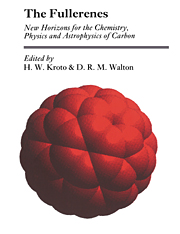Book contents
- Frontmatter
- Contents
- The evolution of the football structure for the C60 molecule: a retrospective
- Dreams in a charcoal fire: predictions about giant fullerenes and graphite nanotubes
- On the formation of the fullerenes
- Production and discovery of fullerites: new forms of crystalline carbon
- Systematics of fullerenes and related clusters
- The fullerenes: powerful carbon-based electron acceptors
- The carbon-bearing material in the outflows from luminous carbon-rich stars
- Elemental carbon as interstellar dust
- The pattern of additions to fullerenes
- Pollyynes and the formation of fullerenes
- Hypothetical graphite structures with negative gaussian curvature
- Fullerenes as an example of basic research in industry
- Deltahedral views of fullerene polymorphism
- Geodesic domes and fullerenes
Fullerenes as an example of basic research in industry
Published online by Cambridge University Press: 03 February 2010
- Frontmatter
- Contents
- The evolution of the football structure for the C60 molecule: a retrospective
- Dreams in a charcoal fire: predictions about giant fullerenes and graphite nanotubes
- On the formation of the fullerenes
- Production and discovery of fullerites: new forms of crystalline carbon
- Systematics of fullerenes and related clusters
- The fullerenes: powerful carbon-based electron acceptors
- The carbon-bearing material in the outflows from luminous carbon-rich stars
- Elemental carbon as interstellar dust
- The pattern of additions to fullerenes
- Pollyynes and the formation of fullerenes
- Hypothetical graphite structures with negative gaussian curvature
- Fullerenes as an example of basic research in industry
- Deltahedral views of fullerene polymorphism
- Geodesic domes and fullerenes
Summary
Some recent trends in industrial basic research are considered. They are driven by a highly competitive global marketplace. The discussion focusses on two recent major scientific advances which have been pursued in industry: high-temperature superconductivity and C60 with its chemical family. Fullerenes appear to be appropriate candidates for basic research in industry.
This paper might be subtitled ‘Research on a Globe, Chemistry on a Sphere’, referring to two very different aspects of the chemical community involved with fullerenes. Research worldwide is undergoing major transformations. Although noticeable in academic and government laboratories, the changes are larger in the industrial sector, especially in companies that have been major centres of basic research for decades. Here we shall consider some of the more prominent developments in industry.
The second aspect is the extraordinary chemistry of C60 and the rapidly increasing family of carbon structures. The chemistry will be that developed at Du Pont; the work of Dr Fagan, Dr Krusic and Dr Tebbe with others. Taylor's contribution in this collection provides an extended consideration of some of the topics and will not be repeated here. Rather we focus on a few features of chemistry on a sphere as opposed to the planar or linear compounds with which we are more familiar.
The bridge between these two parts, and a conclusion, is that basic research on fullerenes may well be an appropriate activity for a modern company dealing with chemicals or materials.
Changes in research philosophy and practice have occurred throughout technologically based industry in recent years. As companies position themselves for a competitive, fast-moving marketplace the fundamental importance of research and technology is rarely questioned.
- Type
- Chapter
- Information
- The FullerenesNew Horizons for the Chemistry, Physics and Astrophysics of Carbon, pp. 129 - 132Publisher: Cambridge University PressPrint publication year: 1993

